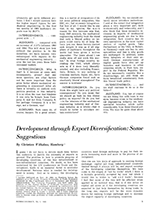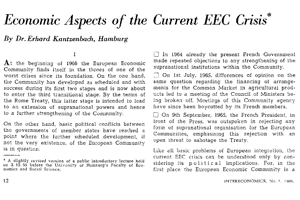Development through Export Diversification: Some Suggestions
Volume 1, January 1966, No. 1
Article published in the first issue of Intereconomics
by Christian Wilhelms
Lecture delivered on Nov. 24, 1965, in Hamburg before the members of a UN Group Training Programme in Trade Promotion organised by the Copenhagen School of Economics and Business Administration. The participants of the Training Programme—export promotion officers from 9 Asian, 1 African and 2 Latin American countries—visited the Hamburg Institute for International Economics to discuss some problems of trade promotion for developing countries.
I guess I do not have to devote much time, before this audience, to justify the necessity of exports in general. The problem is: how to promote progress of developing countries, of the less industrialized or non-industrialized countries. No doubt, as has been underlined by the UN Conference on Trade and Development, trade is an essential factor in economic development. Because what is needed for development is money. And as to money, the developing countries need foreign exchange, to pay for their imports increasing more and more in the process of development.
One can see two ways of approach to earning foreign exchange: capital aid from industrialized countries, limited though it always will be, and export earnings of the developing countries themselves. We here come to the slogan of "aid by trade" which I think is a formula generally accepted by now but which I would like to widen to "aid and trade", because I feel that none of the two will be efficient when applied in an isolated way, that is if one relies on capital aiel alone or if the developing countries are expected to just help themselves by doing trade. In the long run, exports will be the more dynamic means for earning foreign exchange and to increase the import capacity of developing countries.
Export Promotion—A "Must"
In this respect I guess there's some sort of agreement between you and me, since you are here just because of the possibilities for export promotion. There is quite a number of "musts" for developing countries:
- they must develop their economy
- they must provide for imports of capital goods needed for the process of development
- they must earn the foreign exchange necessary to pay for their imports
- they must increase their exports
- they must promote exports.
As to export promotion, there's the well-known problem of the "traditional" products: low prices due to world-wide overproduction, decreasing consumption due to technical and economic progress—substitution through synthetics, more economical use due to technological inventions, vanishing forms of consumption—, and diminished consumption due to change in consumer behavior.
In short: chances for a promotion of traditional primary exports are not too good because what the industrialized countries really need they will buy, and they won't buy more primary products than they need—whether promotion or not. This certainly does not mean that promotion of "traditional" exports is useless or unnecessary from the point of view of an individual country, but it seems to me as though promotion of "traditional" exports cannot raise the level of consumption, it solely means expansion of export sales of one country at the expense of another's.
The Dynamic Way: Diversification
The only really dynamic way of promoting exports, of increasing export earnings beyond the total already reached through "traditional" exports, I would see in the diversification of exports. Therefore, in addition to the "musts" of developing countries already mentioned, export diversification is another must—and, as for the final aims to be reached, perhaps the most decisive one.
Now, what is meant by export diversification? In most generalized terms, it is an expansion of the structure of exports. In a narrower sense, it is the inclusion of "new" products into a country's export programme, so-called "new" products, "small" products, "less known", "less developed" or even "neglected" products. And it goes from agricultural and mineral primary products via semi-manufactures as far as manufactured or industrial products. In a broader sense, export diversification implies the inclusion of new markets:
(1) new industrial sales markets in addition to the traditional outlets,
(2) exports to other developing countries,
(3) exports to the so-called socialist or east-bloc countries.
A more impressive idea on what are the different aspects of export diversification one may obtain from the diagram.
As can perhaps be imagined from the diagram, it's a marvellous instrument, that export diversification. But, just to let there be no vain hopes: it is no magic weapon. It works quite normally in the sense of
- increase of export proceeds
- stabilization of export earnings
- creation of opportunities for employment
- promotion of development through the multiplier effect
- independence of the economy from certain single commodities and from certain single markets and thus: undisturbed growth.
To characterize it a bit more generally, export diversification has a positive meaning, it constitutes an element of intentional doing, of planning for development, of dynamics. It represents a mentality that has to find its expression in the over-all export policy of a country. On the other hand, export diversification, decisive though it may be for the development of a country, does not mean to neglect the export of traditional products. Export diversification is not an end in itself but an instrument to increase exports and to stabilize exports, nothing more. Furthermore, export diversification does not imply its application in the way of exaggerated or senseless diversification—just to spoil traditional exports and to waste efforts through the activity of "terribles diversificateurs".
Approach to Export Diversification
Where is the approach to export diversification? Apart from spontaneous diversification which is the result of the demand coming from foreign markets and of occasional exports, it is intentional diversification that is meant here in the first place. For intentional diversification, there are two ways of approach:
(1) a survey of the potential export products the economy of the developing country referred to may offer
(2) an analysis of the sales possibilities on certain export markets (imports statistics, analysis of local markets).
Data and indications as received from these two forms of approach give a first idea on the possibilities for diversification.
This, however, will not suffice for intentional or planned diversification. Because of the risks and costs involved with intentional diversification one has to go one step further: study the chances that can be expected for a certain product. The next and decisive step therefore is the elaboration of a Product Study. The subject of this type of study is an investigation into all the factors influencing supply and foreign sales of a specific product. The product study need not cover one single foreign market only, but it always takes into consideration solely the factors directly related with the product referred to. It follows the route a product takes from production to final consumer, an uninterrupted chain to be figured out for each product anew. Since already the very first measures in creating a product must be directed towards the final consumer, there are two objects of research: the product, being the starting point, and the final consumer, deciding on the success of the diversification attempted.
The product study as developed in our research work is subdivided into three parts:
(1) description of the special physical and technical characteristics of the product in question, its production conditions and problems involved and its present and potential fields of application;
(2) analysis of the supply situation:
production volumes, domestic processing or domestic consumption, resp., supply to be expected, and the factors influencing exports of the producing country itself;
(3) investigation into the demand situation:
markets (international and in particular the export market aimed at),
imported volumes, channels of distribution, intended use in the importing country, competitive situation (home production, imports from other countries, substitution),
import regulations and other stipulations influencing consumption of a certain product.
The investigation, as indicated above, of production conditions and its bottlenecks and obstacles, on the one side, and of the situation on the sales market and the existing chances and risks, on the other, enables the exporting country to find out what difficulties will have to be overcome and what chances for success there are likely to exist. The product study approach is particularly practicable for the promotion of products neglected so far, for avoiding set-backs in endeavouring to launch completely new products, and for the control of the chances to increase the present main exports or of the reasons for decreasing sales observed.
Important Prerequisites
Export diversification, as might have become apparent from what has been said so far, is not quite as easy as the many suggestions for diversification of exports the developing countries should follow. Export diversification is not simply a matter of "well, now let's diversify". It takes some prerequisites and some efforts.
First, there must be certain basic assets to start from, there must be somewhat more than a mere desert of nothing: be it natural resources, skilled labour, fertile soil, strange and unknown fruits and what more. Secondly, there must be someone to do the diversification job or at the least give some hints. And there should be somebody to work out the product studies mentioned before. All this might be done by some special kind of Export Promotion Organisation. Not in the form of the traditional Export Offices or Export Bureaus.
The task of an Export Promotion Organisation like that would have to be:
(1) elaboration of product studies as described before,
(2) the initiation, through divulgation of the results of such studies, of endeavours for diversification,
(3) the establishment of contacts between producers or exporters in the developing country and import firms, marketing organisations and the like, in industrial states.
This method of proceeding offers the advantage that the full knowledge gained in the elaboration of the product studies is utilized, that the efforts of the individual firm can be directed towards the way of success, that risks may be avoided, and that existing contacts can be used. Because as to contacts in industrial countries, it is just as decisive to know the adequate channels of distribution as to offer an interesting product, interesting from the point of view of competitive prices and quality.




